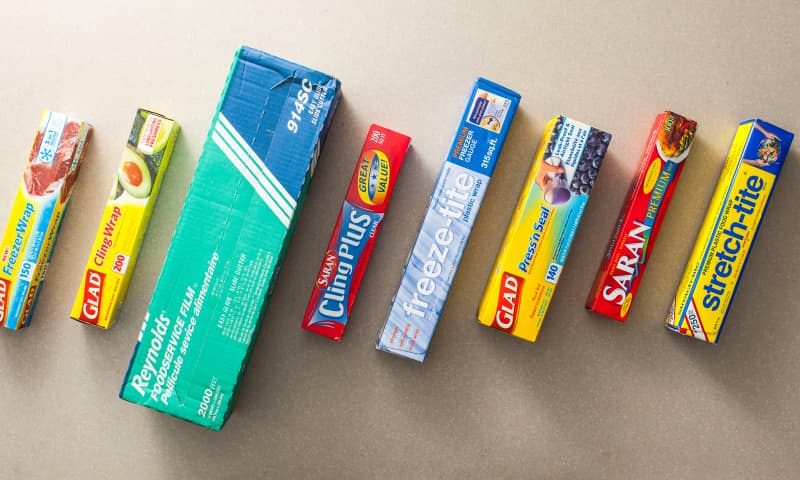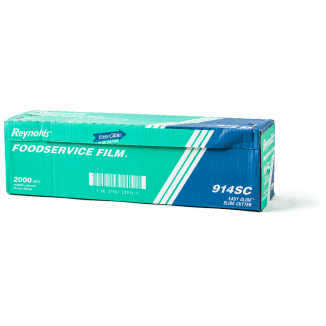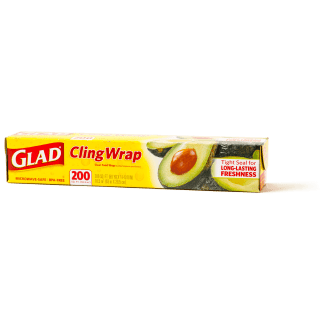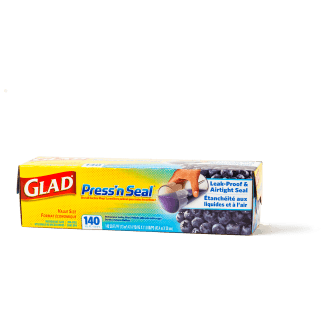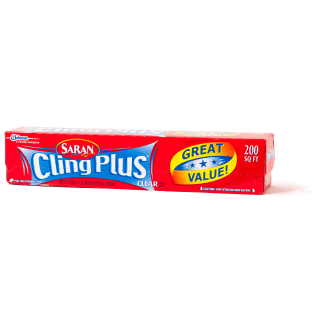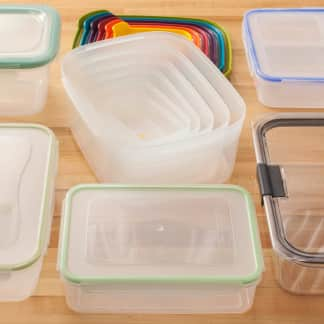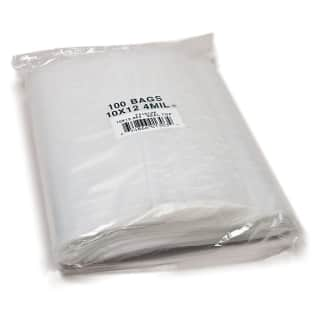We rely on plastic wrap to help store and freeze food and to perform certain kitchen tasks, such as pounding cutlets and making logs of cheese, cookie dough, or compound butter. But plastic wrap can be a pain to use: We’ve all cut ourselves on the dispensers’ serrated blades, accidentally broken the boxes, or watched helplessly as the plastic wrap stuck to itself, preventing us from getting a neat, easy-to-use square of film.
We wanted to find a wrap that would cling tightly to different containers and also be easy to dispense and use. So we rounded up the seven top-selling plastic wraps (according to IRI, a Chicago-based market research firm), as well as a bulk food-service wrap that is available online.
The Cling’s the Thing
For many of us, the key characteristic of plastic wrap is its cling. To see how sticky the wraps were, we put 8 ounces of grapes in vessels of different materials (metal, glass, and plastic bowls and our favorite broiler-safe ceramic baking dish) and used a sheet of plastic to cover each container. Then we turned the containers upside down and shook them. All the wraps clung well to metal, glass, and ceramic. But the two products made by Saran refused to adhere to the plastic bowl, allowing grapes to spill out.

Wondering why these wraps had failed, we consulted Robert Heard, teaching professor in the Department of Materials Science and Engineering at Carnegie Mellon University. He explained that all plastic wraps are made from one of two basic types of materials: polyvinyl chloride or polyethylene. Each wrap gets its cling not from these base materials, but rather from proprietary adhesives that manufacturers add. The composition of each adhesive determines how well the wrap sticks to specific materials, so an adhesive that clings tightly to glass might not do as well with plastic. We preferred products that clung well to all the materials we tested.
Thicker Wraps Are More Durable
We also examined how well the wraps resealed, using one sheet to seal and reseal a glass bowl of grapes 10 times, shaking the bowl after every attempt. All the wraps were capable of resealing each time—as long as there was enough material left. Upon restretching, some wraps tore at the edges, giving us less and less material to work with. Thinner wraps bent out of shape easily and sometimes ripped right down the middle as we tugged them, forming holes that allowed the grapes to escape. We had the wraps measured by an independent lab and found that those that tore more easily were less than 0.5 millimeters thick. The other wraps were more durable, resisting tears and deformation; at 0.68 millimeters, our favorite was the thickest of the bunch.
In theory, thicker wraps—often marketed as freezer wraps—should also protect food from freezer burn better than thinner wraps because they form a more substantial barrier for moisture or oxygen to travel through. To evaluate this, we wrapped chicken cutlets in each plastic wrap, placed them flat in freezer bags, and froze them, checking them for ice crystals once a week. We saw no difference in the quality of the chicken cutlets, all of which remained tightly wrapped and crystal-free even after two months.
Width Matters
We were surprised to learn that the commercial wrap in our lineup was actually one of the thinnest and tore under stress. Why, then, do many of our test cooks prefer similar food-service wraps? Width. While consumer-grade plastic wraps are about a foot wide, commercial wraps come in 18- and 24-inch-wide rolls, allowing you to cover more area in a single pass. This greater coverage helps when you’re wrapping large containers, baking sheets, or cuts of meat.
Size was certainly an advantage when we used each wrap to cover chicken breasts and pound them into cutlets. A single sheet of the commercial wrap encased the cutting board to keep it clean; a second sheet covered all four chicken breasts with room to spare. By contrast, it took at least two sheets of most consumer-grade wraps to cover the board and another two to cover the chicken. However, we realized that the size of commercial wrap is overkill for most home cooks; you don’t need an 18-inch swath of plastic to help form a cheese log, for example, and these products are sold in bulk (1,000 square feet or more), so they take up a lot of space.
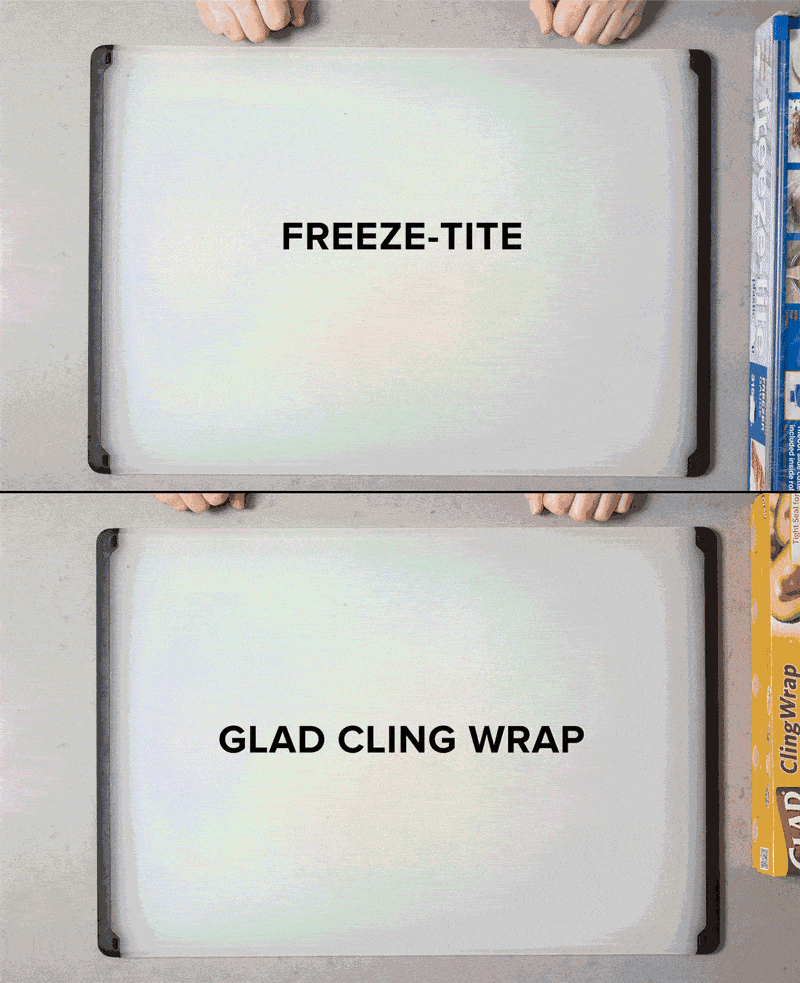
Luckily, one product provides a happy medium. At 15 inches across, our favorite wrap is large enough to cover a cutting board (or four chicken breasts) with a single sheet, but its box is still small enough that it can be tucked into a kitchen drawer.
On a Tear
Finally, we looked at how easy the wraps were to dispense and use over time, dealing out 100 foot-long sheets from each box. The type of cutting implement was critical. Some products have serrated blades, while others include a slide cutter. The serrated blades felt less safe and were often a pain to use, since we needed one hand to tear the plastic and the other to stabilize the box. It was also tricky to get a nice, clean-edged piece of plastic: With these products, the wrap can stretch and bend over the blade instead of severing neatly, and the tearing motion encourages the plastic to come into contact with itself and cling together.
Worse, tearing puts stress on the box, gradually breaking it down over time and making it harder to use. This breakdown was particularly pronounced in products where the blade was on the box flap and not on the box edge. With every use, these flaps strained, bulged, and deformed. After dispensing 100 sheets, one blade had partially detached from the flap.
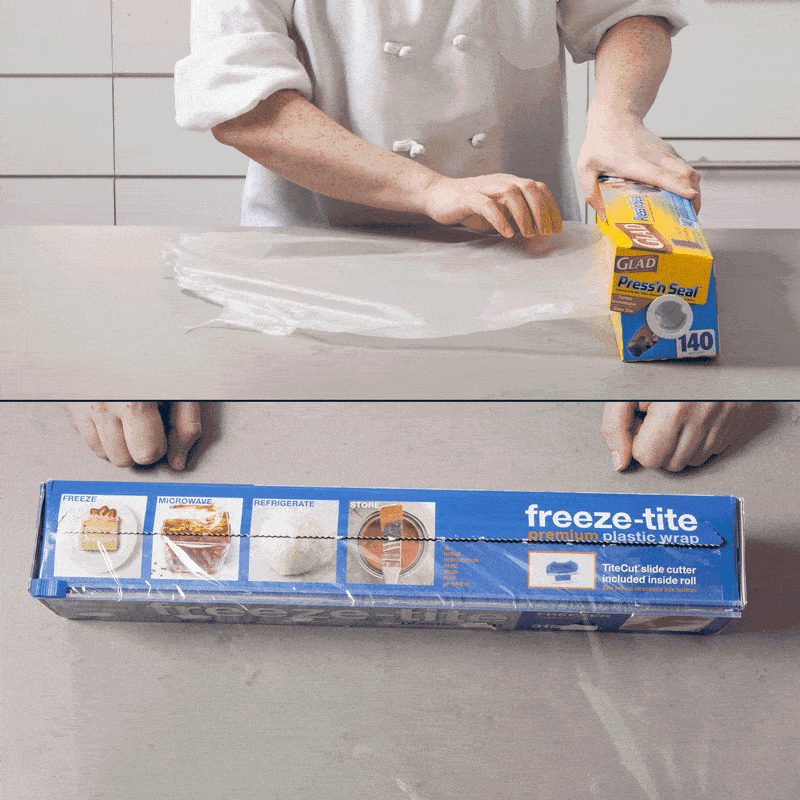
Most testers preferred the slide cutters found on three products. Without an exposed blade, these felt safer to use. They were also easier, since you need only one hand to move the slider across the plastic, which stays put. This results in clean, straight cuts and reduces the risk that the plastic will stick to itself. And because you’re not constantly fighting the box to tear off sheets, the package holds up better over time, too.
A Solid Choice
Our winner is Freeze-Tite Clear High Cling Freezer Wrap. Its thick plastic was super clingy and remarkably durable, resisting tears and punctures. And its width—halfway between those of standard consumer-grade wrap and food-service wrap—made it ideal for tasks large and small. Best of all, it has both a serrated blade and an easy-to-use slide cutter, which ensured that we got a perfect sheet every time. For a less expensive option, our Best Buy is Freeze-Tite’s little sibling, Stretch-Tite Premium Plastic Food Wrap. It’s thinner and narrower, so it’s a little less durable and versatile, but it clings just as well and is available with a slide cutter just like the one we loved in our winner.
The Tests
- Use to wrap vessels of different materials (metal, glass, and plastic bowls, plus our favorite broiler-safe ceramic baking dish)
- Use to wrap glass bowls; place in refrigerator and monitor cling weekly for 2 months
- Seal and reseal glass bowl 10 times
- Cover 14½ by 21-inch plastic cutting board and use to protect chicken while pounding into cutlets
- Use to roll cheese logs
- Enclose chicken breasts for freezing, checking for ice crystals weekly for 2 months
- Dispense 100 foot-long sheets
- Ask 5 users with different dominant hands to use and evaluate
How We Rated
- Cling: We evaluated how well each wrap clung to vessels of different materials over short and long periods.
- Wrap Durability: We rated the wraps on their strength and resilience.
- Ease of Use: We considered how easy each wrap was to dispense and how easy it was to use in a number of kitchen applications.
- Dispenser Durability: We evaluated how well the dispensers held up over time and how susceptible they were to damage.
- Clings to variety of materials
- Thick and durable
- 15 inches wide
- Includes slide cutter
